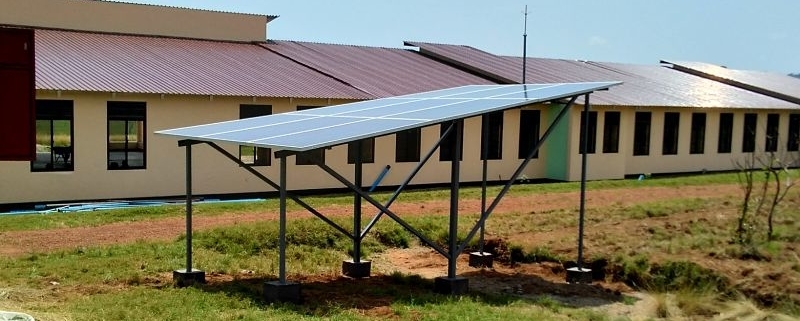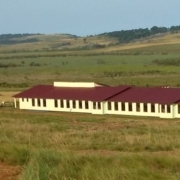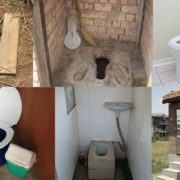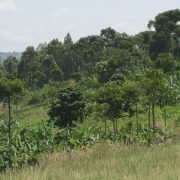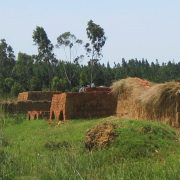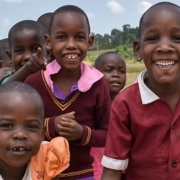Solar Power at Twegashe School
Early last year we began working together with the Seattle International District Rotary Club and the Rotary Club of Bukoba to apply for a Rotary district matching grant for solar power at Twegashe School. In early February that effort came to fruition with the installation of a solar power system at the school.
Grant application
The grant application process was spearheaded by Judy Ginn of the Seattle International District Rotary Club. We can’t thank Judy enough for all that she did to make this project happen! Judy invested months of hard work drafting the grant application and then making presentations and soliciting donations from individual Seattle-area Rotary clubs to be matched by their Rotary District. She turned the application in to the District 5030 grants approval committee in September 2020, the grant was approved in October, and funds for the project became available in November.
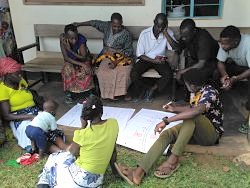 The Bukoba Rotary Club was the host-country club for this project. Last February, near the beginning of the application process, they conducted a needs assessment in Bushasha Village. They gathered a cross-section of villagers to participate in the assessment. Not surprisingly, improvements in education emerged as one of the key needs of the village. As the host-country club, the Bukoba Rotary was also responsible for managing the finances of the project in Tanzania and reporting to the Seattle International District club back in the US regarding the progress of the project.
The Bukoba Rotary Club was the host-country club for this project. Last February, near the beginning of the application process, they conducted a needs assessment in Bushasha Village. They gathered a cross-section of villagers to participate in the assessment. Not surprisingly, improvements in education emerged as one of the key needs of the village. As the host-country club, the Bukoba Rotary was also responsible for managing the finances of the project in Tanzania and reporting to the Seattle International District club back in the US regarding the progress of the project.
To apply for a Rotary grant we had to submit a detailed budget proposal. After estimating what the power needs of the Phase I building would be for the foreseeable future, we secured quotes from four different solar companies, three in Arusha and one in Dar es Salaam. The company we landed on was Photons Energy, a Tanzanian company based in Arusha, a 16 hour bus-ride from Bukoba. Although it wasn’t a factor in our choice of company, we were pleased to be able to patronize a company founded and run by four Tanzanians who all grew up in rural villages like Bushasha!
After the grant approval in November and the signing of a contract between Photons Energy and the Bukoba Rotary in December, Photons immediately placed an order for a 15kWh lithium ion battery pack to provide the energy storage needed here in Bushasha, where it can rain for several days at a time with no sunshine break. Photons Energy had all the other components of the system (inverter, charge controller, etc.) in stock, but they don’t keep lithium batteries in stock since few customers in Tanzania choose them. We chose lithium batteries as more environmentally friendly than lead acid batteries. They are also more economical in the long term because of their long life-time.
Preparations
At the beginning of February this year we received a message from Photons that the batteries had arrived in Arusha and that the installation crew would be leaving for Bushasha in a few days. They inquired regarding accommodations in the Bushasha area, so Michael made some phone calls. We discovered that in the nearby village of Rwangono, at the junction with the main road to town, there is an eight-room guest house which has indoor plumbing and even hot showers! That suited the crew just fine. (Maybe we’ll need to take a weekend vacation in Rwangono one of these days, since there are definitely no hot showers at our house in Bushasha!)
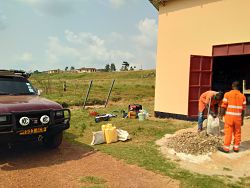 On Monday February 8, a Photons Energy Landcruiser arrived at Twegashe School with three crew members and all the components of the school’s solar power system. After some friendly introductions, the crew leader, Daniel Moshi, checked out the planned location for the solar panel structure and for the batteries and other components of the system. He confirmed that the inside wall of the storage shed behind the classroom building would be adequate for the system components, but he indicated one small problem…the inside of the storage shed was not painted (because it’s just a storage shed!) “That won’t look good in photos.” “Okay, we’ll have it painted. Do you want green or butterscotch?” They chose butterscotch, a member of the painting crew was diverted to that task, and by the following day they had a lovely butterscotch background for the equipment.
On Monday February 8, a Photons Energy Landcruiser arrived at Twegashe School with three crew members and all the components of the school’s solar power system. After some friendly introductions, the crew leader, Daniel Moshi, checked out the planned location for the solar panel structure and for the batteries and other components of the system. He confirmed that the inside wall of the storage shed behind the classroom building would be adequate for the system components, but he indicated one small problem…the inside of the storage shed was not painted (because it’s just a storage shed!) “That won’t look good in photos.” “Okay, we’ll have it painted. Do you want green or butterscotch?” They chose butterscotch, a member of the painting crew was diverted to that task, and by the following day they had a lovely butterscotch background for the equipment.
For their first night here, Michael went with our visitors to Rwangono to make sure their accommodations were comfortable. He reported afterward that the crew was a lot of fun to be around and very “all-weather”, not at all difficult to please. But they did have very definite preferences, one of which was to eat fish from Lake Victoria for dinner (Arusha is land-locked!). Fortunately, their guest house in Rwangono serves meals, custom-ordered. Michael helped them order some fish but it took a while to explain to the cook that they wanted nice, thick fish steak, not soup made from bony small fish, which is what most people here can afford. Apparently the meal suited them, because for their remaining days at Twegashe they had lunches from that guest house delivered to the school by pikipiki (motorcycle).
Installation
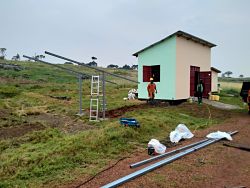 The next day Daniel’s crew got right to work building the steel structure for the solar panels. When Photons designed our system, they suggested that the panels not be placed on the roof since the roof faces east-west. They explained that here, just south of the equator, the panels should ideally slant slightly toward the north to get the highest efficiency. A very small angle would be best in terms of the position of the sun, but more angle is better for allowing dirt to run off after a rain. The compromise they suggested was 10 degrees. For those readers interested in additional technical details, the nine 325W solar panels were installed on the structure in a 3-by-3 array with a maximum current rating of 20.97Amps.
The next day Daniel’s crew got right to work building the steel structure for the solar panels. When Photons designed our system, they suggested that the panels not be placed on the roof since the roof faces east-west. They explained that here, just south of the equator, the panels should ideally slant slightly toward the north to get the highest efficiency. A very small angle would be best in terms of the position of the sun, but more angle is better for allowing dirt to run off after a rain. The compromise they suggested was 10 degrees. For those readers interested in additional technical details, the nine 325W solar panels were installed on the structure in a 3-by-3 array with a maximum current rating of 20.97Amps.
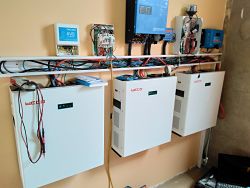 Once the outside items – panels, wiring, circuit breakers, and lightning protection device – had been installed, the Photons crew began installing the other components of the system. These included a 3,000W pure sign wave inverter to convert the DC power produced by the solar panels to AC, a 60 amp MPPT (Maximum Power Point Tracking) charge controller to regulate how much power goes to the battery, a variety of circuit breakers, a bank of three lithium ion solar batteries with total capacity 14.85kWh, and a device for monitoring system performance. All of these components were installed inside the storage shed. The monitoring device will allow Photons to keep tabs on the performance of our solar system, provided the internet data connectivity is adequate—a question we are still investigating. If the connectivity is not adequate, we will need to monitor the system ourselves. The entire system is equipped with grounding and breakers to protect it from damage and also to ensure user safety.
Once the outside items – panels, wiring, circuit breakers, and lightning protection device – had been installed, the Photons crew began installing the other components of the system. These included a 3,000W pure sign wave inverter to convert the DC power produced by the solar panels to AC, a 60 amp MPPT (Maximum Power Point Tracking) charge controller to regulate how much power goes to the battery, a variety of circuit breakers, a bank of three lithium ion solar batteries with total capacity 14.85kWh, and a device for monitoring system performance. All of these components were installed inside the storage shed. The monitoring device will allow Photons to keep tabs on the performance of our solar system, provided the internet data connectivity is adequate—a question we are still investigating. If the connectivity is not adequate, we will need to monitor the system ourselves. The entire system is equipped with grounding and breakers to protect it from damage and also to ensure user safety.
Another task for the Photons crew was to dig trenches and lay the cable connecting the solar power system to the existing electrical wiring of the school building. They also laid additional cable to connect to the staff toilets and to the student toilet block.
On Friday two members of the Bukoba Rotary surprised us with a short visit to check on the progress of the installation. They were pleased to see that everything was going smoothly and that the project was already nearly completed. These same Bukoba Rotary members had participated in the needs assessment last year – presumably they were happy to see their efforts now coming full circle.
System capabilities
Daniel spent some time while his colleagues were installing the equipment to talk with us about the school’s future energy needs and the capabilities of the system they were installing. We assured him that the energy needs we had reported when requesting the quote (numbers of electrical devices and hours per day for each device) were all that we anticipated for the Phase 1 building. Our plan is to have a second solar system to service the Phase 2 classroom building rather than expanding this system. Daniel pointed out that if we tax the system beyond the energy use that it was designed for the batteries will be drained excessively and this will shorten their lifetime, so we will need to be somewhat disciplined about our use of energy. This kind of training about energy conservation will be valuable to our students beyond the context of Twegashe School.
Since the national electrical company, TANESCO, will soon be delivering grid power to Bushasha (the poles and wires are all nearly in place) we requested that the system include a switch so that we can switch to grid power manually if necessary. Daniel also suggested that if we decide in the future to add a high-energy-use appliance (the example he used was a dishwasher, something we have never even once dreamed of having here!) we would need to install a dedicated circuit connecting this appliance to the electrical grid. He emphasized that this solar power system doesn’t have the capability to run such an item in addition to the lights, computers, classroom projectors, printer, and small refrigerator that it was designed for.
Maintenance and operations training
 By Saturday morning, the Photons crew had completed the installation, programming, and testing of Twegashe’s solar power system. Their final task was to provide training on the maintenance and operation of the system. We recruited two parents and two members of the construction crew who live in Bushasha to participate in this training. The aim is to have multiple people here on site or nearby able to help keep the panels clean and monitor the system to make sure it is working properly. As Daniel emphasized several times, this training did NOT qualify participants to make repairs on the system. (The only tool allowed is a screwdriver to open the cover of the outside circuit breakers to check their status!)
By Saturday morning, the Photons crew had completed the installation, programming, and testing of Twegashe’s solar power system. Their final task was to provide training on the maintenance and operation of the system. We recruited two parents and two members of the construction crew who live in Bushasha to participate in this training. The aim is to have multiple people here on site or nearby able to help keep the panels clean and monitor the system to make sure it is working properly. As Daniel emphasized several times, this training did NOT qualify participants to make repairs on the system. (The only tool allowed is a screwdriver to open the cover of the outside circuit breakers to check their status!)
Daniel provided a brief overview on how the system functions. He explained how to clean the solar panels, how and when to flip circuit breakers, and how to interpret the signal lights on the charge controller, inverter, and batteries. He also showed those of us with smartphones how we can connect to the monitoring device via Bluetooth to view all the technical details of system performance, both in real time and historically. Daniel was clearly very knowledgeable about solar power and electrical systems, but we discovered that he is also a very good teacher.
After the two-hour training session, the Photons crew had lunch and then packed up their Landcruiser and headed out. It was a bit intimidating to be left alone with this new “baby”, but Daniel assured us that the Photons team are available any time of the day or night if we need help. It’s been several weeks now and the system just keeps humming along without incident. We’re glad to know our fears on being left alone with this new solar power system were unfounded!
Benefits of electricity
 We haven’t had any night-time functions yet to see the full benefit of having electricity at the school. But Twegashe’s cook always arrives at school before dawn to begin preparing morning porridge, so she has been taking advantage of the new lights in the kitchen. Lights also help to brighten up the classroom on Bushasha’s many gray mornings.
We haven’t had any night-time functions yet to see the full benefit of having electricity at the school. But Twegashe’s cook always arrives at school before dawn to begin preparing morning porridge, so she has been taking advantage of the new lights in the kitchen. Lights also help to brighten up the classroom on Bushasha’s many gray mornings.
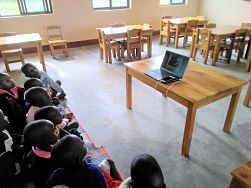 But electricity at the school means a lot more than just lighting. Teachers and students are seeing the advantages for instruction already. Today Madam Joan used our laptop to show the kindergartners a video of simple, real-life dialogues for kids – a great opportunity for them to hear naturally spoken English and to get a view of English life at the same time. And Madam Editha’s first grade class is talking about the sun and shadows for science. She wanted to read them the book Bear Shadow, but we don’t have a copy of the book here at school. Instead she was able to share a Youtube read-aloud version of the book. The children were thrilled with both of these activities!
But electricity at the school means a lot more than just lighting. Teachers and students are seeing the advantages for instruction already. Today Madam Joan used our laptop to show the kindergartners a video of simple, real-life dialogues for kids – a great opportunity for them to hear naturally spoken English and to get a view of English life at the same time. And Madam Editha’s first grade class is talking about the sun and shadows for science. She wanted to read them the book Bear Shadow, but we don’t have a copy of the book here at school. Instead she was able to share a Youtube read-aloud version of the book. The children were thrilled with both of these activities!
Thank you, Rotary!
In closing, we want to give one more enthusiastic thank you to Rotary, and specifically to the clubs of District 5030 listed below who contributed to this project. The Twegashe School solar power project that they have made possible will contribute toward improved education for Bushasha’s children for many years to come!
District 5030 clubs who contributed to the Twegashe Solar Power Project:
Seattle International District Rotary Club
Shoreline Rotary Club
Lake Forest Park Rotary Club
Kent Rotary Club
Mill Creek Rotary Club
Auburn Rotary Club
Kirkland Downtown Rotary Club
Northshore Rotary Club
University District Rotary Club
Redmond Rotary Club
University Sunrise Rotary Club
Emerald City Rotary Club
Mercer Island Rotary Club
Bellevue Rotary Club
Lake Union Rotary Club

